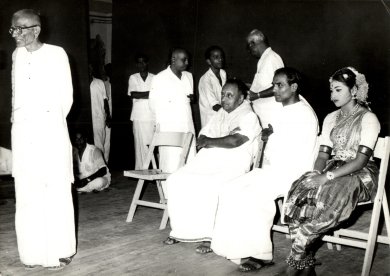 |
  |
 |
  |
K. N. Dandayudhapani Pillai Baani - Hema Rajagopalan e-mail: hema@natya.com March 26, 2016  K. N. Dandayudhapani Pillai was born on July 14, 1921 at Kaaraikaal and belonged to a family of musicians. His father A. K. Natesa Pillai was a famous musician under whom he studied music. At the age of 12 he began to give regular concerts. However, his grandfather Ramakrishna Pillai was a well known Bharatanatya vidvan who trained Dandayudhapani in the art of Bharatanatyam. Dandayudhapani Pillai taught at Kalakshetra for 7 years. He was also a relative of Pandanallur Meenakshi Sundaram Pillai and had the opportunity to interact and work with him, according to what he told us. I came under Vaadyar's tutelage in 1959 after my initial training under Swarna Saraswathi who belonged to a distinguished family of dancers. She received her training from Kanchipuram Thiruvangadu Nattuvanar, Mylapore Gowri Amma and Chinnaiyya Naidu. So when I danced it was with more of an emphasis on abhinaya. When I came under Vaadyar's tutelage, I remember starting from scratch and being corrected for my posture, stance, more anga sudham. His baani consisted of paying a lot of importance to clean lines and stances, correct positioning of hastas and he gave a lot of emphasis on how the hand moved from one position to the other. He used to insist that the geometry be maintained at all costs. At the same time delivery of movement vocabulary was always accompanied by grace and expression. He was known for his choreography in terms of pure dance segments. He clearly had a plan to place the movements in a very calculated geometrical pattern. He made sure that space was utilized in every way possible, so that the dance was never always done in the same spot. Apart from the space utilization, he would make sure that the adavus were not repeated. Also he was very good in seeing what movement looked good on a particular body and mount choreography accordingly. He was certainly a genius in creating jathis; his kanakku was always very complex and interesting and often juxtaposed with pauses such that at one point a critic wrote that I was taking breaks in between the jathi. The sollukattu for the jathis also were interestingly laid out so that it was never redundant to the ears. His baani certainly can be recognized by his bristling jathis and korvais and nritta segments and the way the dancer moved and covered space, how the adavus were combined to give kaleidoscopic patterns. He was a very good musician and thus was able to compose several compositions like jathiswarams, thillanas, varnams and kirtanams which included some secular themes too and age appropriate compositions which could be taught to younger dancers. The subject varied covering a large range. I certainly feel a baani is something that becomes a part of the dancer's art after several years of first the tutelage of gurus and then the practice of that art which certainly undergoes enhancement because of several factors such as time, audience, needs - whether it is the need to communicate in certain way or the need to reflect introspectively. An artiste is an artiste because of the creativity that exists in that person. And if this style is somehow popular or the artiste is able to sustain it then it stays as a baani, I believe. I certainly do not dance or create my choreography the way my Guru did but I can state that in all my works his influence is there. Hema Rajagopalan is the founder and artistic director of Natya Dance Theatre, Chicago. Post your comments Please provide your name and email id along with your comment. All appropriate comments posted with name and email id in the blog will also be featured in the site. |